Murdoch University: Managing Remuneration, Rewards and Benefits Report
VerifiedAdded on 2022/12/28
|6
|1438
|21
Report
AI Summary
This report analyzes the suitability of existing statutory awards for CUAP's growth, emphasizing minimum wages, bonuses, and overtime. It addresses the gender pay gap by ensuring equal pay based on skills, talent, and job roles, irrespective of gender. The report applies Armstrong's total reward model, integrating compensation, benefits, work-life balance, performance management, talent development, and recognition. Strategic rewards, encompassing extrinsic (incentives, bonuses) and intrinsic (positive feedback, acknowledgment) approaches, are recommended to boost employee motivation and support CUAP's objectives. The report highlights the importance of both monetary and non-monetary rewards to foster a positive work environment and drive employee engagement. The study emphasizes that remuneration and rewards will keep the employees of CUAP happy and motivated to do their jobs, provided accompanying factors like a positive work environment and good or motivational leadership is also present and which will give them the boost they need to work to potential.
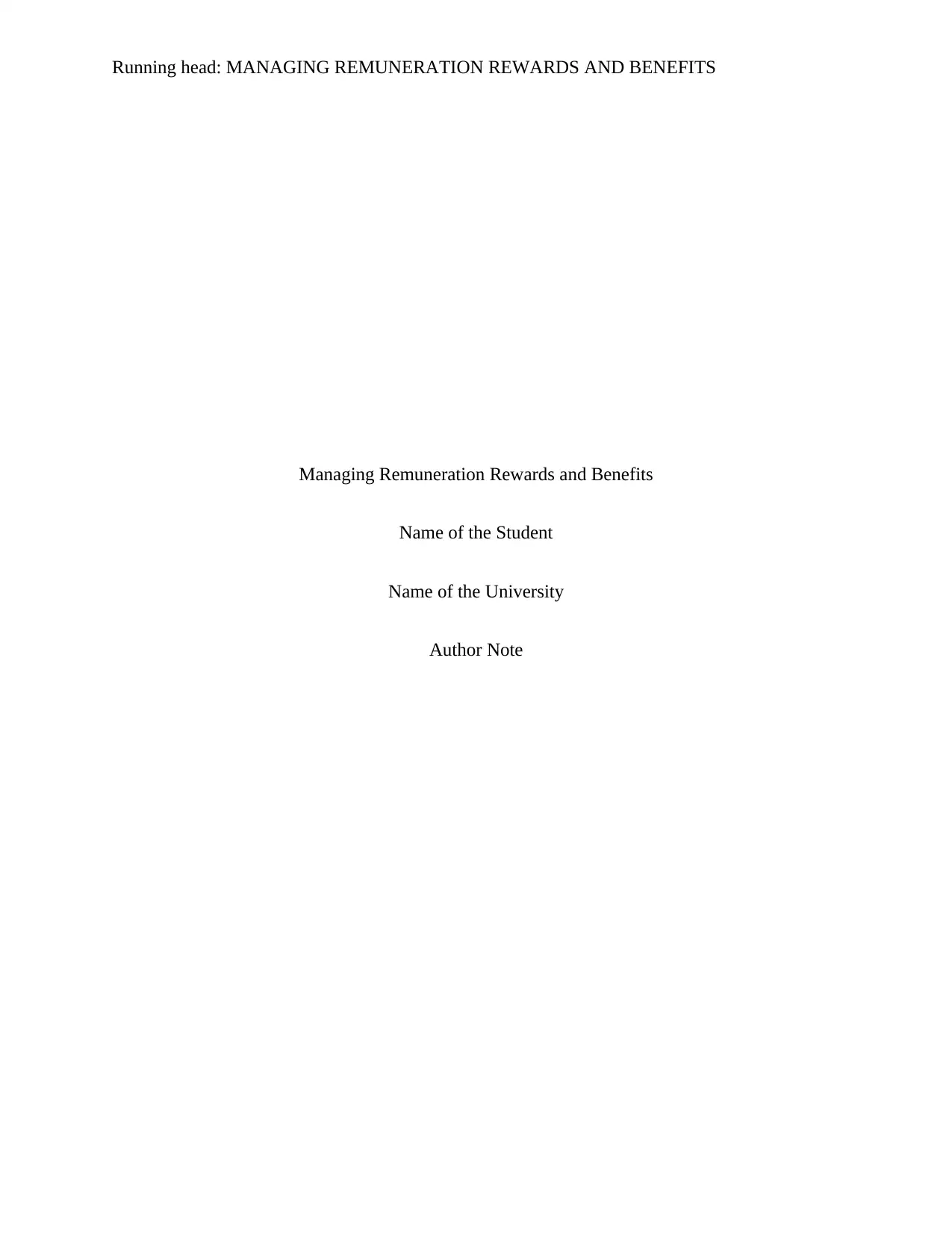
Running head: MANAGING REMUNERATION REWARDS AND BENEFITS
Managing Remuneration Rewards and Benefits
Name of the Student
Name of the University
Author Note
Managing Remuneration Rewards and Benefits
Name of the Student
Name of the University
Author Note
Paraphrase This Document
Need a fresh take? Get an instant paraphrase of this document with our AI Paraphraser
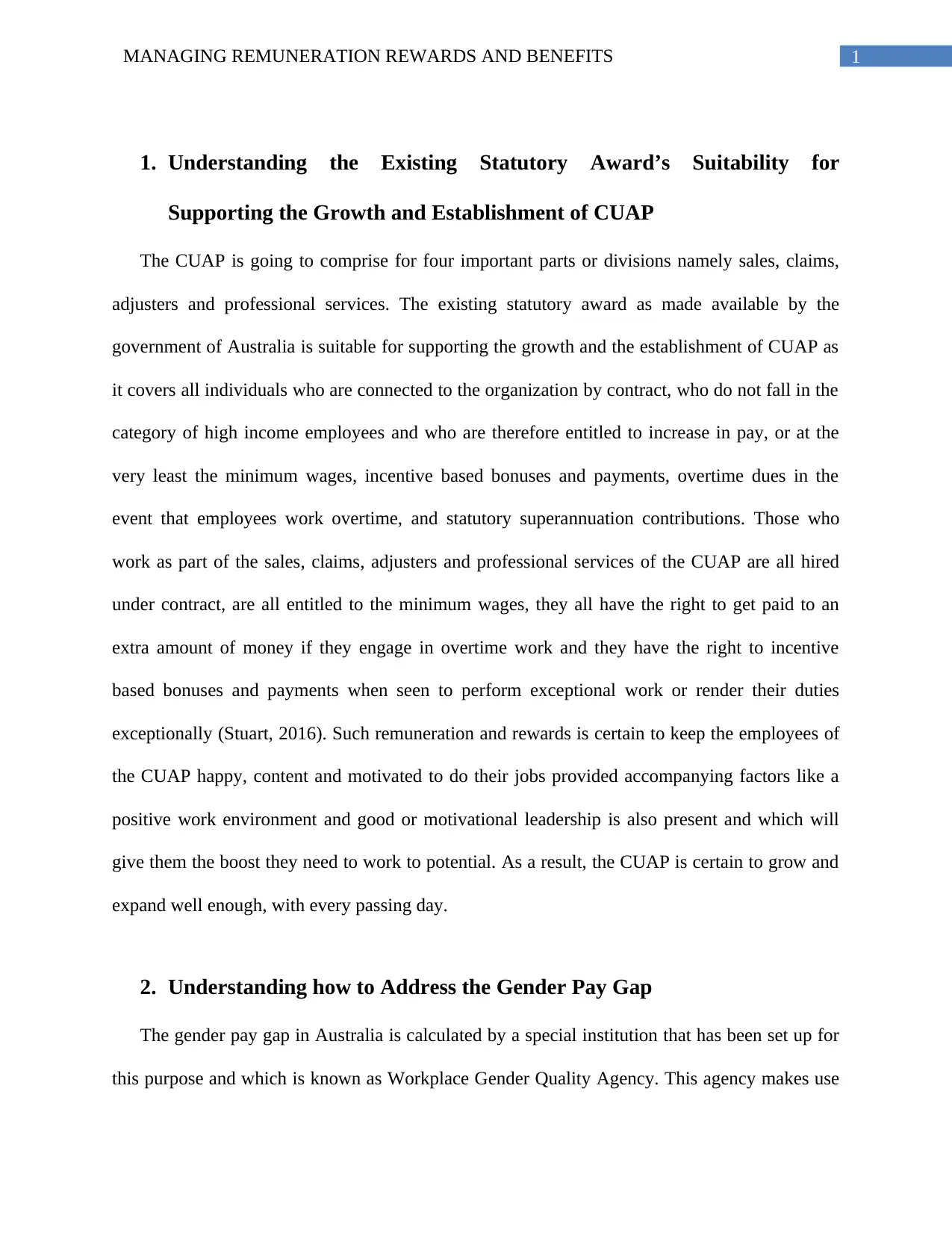
1MANAGING REMUNERATION REWARDS AND BENEFITS
1. Understanding the Existing Statutory Award’s Suitability for
Supporting the Growth and Establishment of CUAP
The CUAP is going to comprise for four important parts or divisions namely sales, claims,
adjusters and professional services. The existing statutory award as made available by the
government of Australia is suitable for supporting the growth and the establishment of CUAP as
it covers all individuals who are connected to the organization by contract, who do not fall in the
category of high income employees and who are therefore entitled to increase in pay, or at the
very least the minimum wages, incentive based bonuses and payments, overtime dues in the
event that employees work overtime, and statutory superannuation contributions. Those who
work as part of the sales, claims, adjusters and professional services of the CUAP are all hired
under contract, are all entitled to the minimum wages, they all have the right to get paid to an
extra amount of money if they engage in overtime work and they have the right to incentive
based bonuses and payments when seen to perform exceptional work or render their duties
exceptionally (Stuart, 2016). Such remuneration and rewards is certain to keep the employees of
the CUAP happy, content and motivated to do their jobs provided accompanying factors like a
positive work environment and good or motivational leadership is also present and which will
give them the boost they need to work to potential. As a result, the CUAP is certain to grow and
expand well enough, with every passing day.
2. Understanding how to Address the Gender Pay Gap
The gender pay gap in Australia is calculated by a special institution that has been set up for
this purpose and which is known as Workplace Gender Quality Agency. This agency makes use
1. Understanding the Existing Statutory Award’s Suitability for
Supporting the Growth and Establishment of CUAP
The CUAP is going to comprise for four important parts or divisions namely sales, claims,
adjusters and professional services. The existing statutory award as made available by the
government of Australia is suitable for supporting the growth and the establishment of CUAP as
it covers all individuals who are connected to the organization by contract, who do not fall in the
category of high income employees and who are therefore entitled to increase in pay, or at the
very least the minimum wages, incentive based bonuses and payments, overtime dues in the
event that employees work overtime, and statutory superannuation contributions. Those who
work as part of the sales, claims, adjusters and professional services of the CUAP are all hired
under contract, are all entitled to the minimum wages, they all have the right to get paid to an
extra amount of money if they engage in overtime work and they have the right to incentive
based bonuses and payments when seen to perform exceptional work or render their duties
exceptionally (Stuart, 2016). Such remuneration and rewards is certain to keep the employees of
the CUAP happy, content and motivated to do their jobs provided accompanying factors like a
positive work environment and good or motivational leadership is also present and which will
give them the boost they need to work to potential. As a result, the CUAP is certain to grow and
expand well enough, with every passing day.
2. Understanding how to Address the Gender Pay Gap
The gender pay gap in Australia is calculated by a special institution that has been set up for
this purpose and which is known as Workplace Gender Quality Agency. This agency makes use
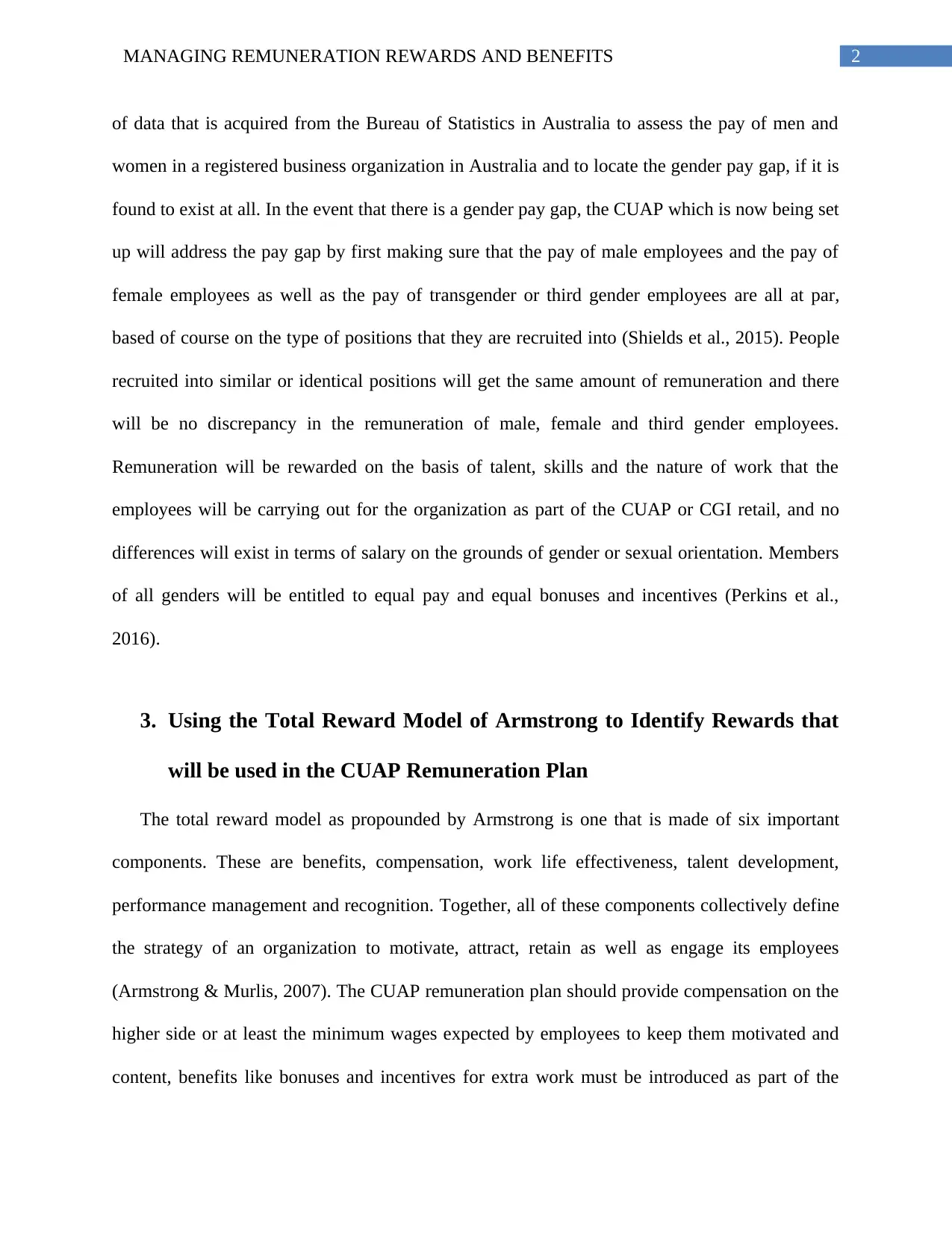
2MANAGING REMUNERATION REWARDS AND BENEFITS
of data that is acquired from the Bureau of Statistics in Australia to assess the pay of men and
women in a registered business organization in Australia and to locate the gender pay gap, if it is
found to exist at all. In the event that there is a gender pay gap, the CUAP which is now being set
up will address the pay gap by first making sure that the pay of male employees and the pay of
female employees as well as the pay of transgender or third gender employees are all at par,
based of course on the type of positions that they are recruited into (Shields et al., 2015). People
recruited into similar or identical positions will get the same amount of remuneration and there
will be no discrepancy in the remuneration of male, female and third gender employees.
Remuneration will be rewarded on the basis of talent, skills and the nature of work that the
employees will be carrying out for the organization as part of the CUAP or CGI retail, and no
differences will exist in terms of salary on the grounds of gender or sexual orientation. Members
of all genders will be entitled to equal pay and equal bonuses and incentives (Perkins et al.,
2016).
3. Using the Total Reward Model of Armstrong to Identify Rewards that
will be used in the CUAP Remuneration Plan
The total reward model as propounded by Armstrong is one that is made of six important
components. These are benefits, compensation, work life effectiveness, talent development,
performance management and recognition. Together, all of these components collectively define
the strategy of an organization to motivate, attract, retain as well as engage its employees
(Armstrong & Murlis, 2007). The CUAP remuneration plan should provide compensation on the
higher side or at least the minimum wages expected by employees to keep them motivated and
content, benefits like bonuses and incentives for extra work must be introduced as part of the
of data that is acquired from the Bureau of Statistics in Australia to assess the pay of men and
women in a registered business organization in Australia and to locate the gender pay gap, if it is
found to exist at all. In the event that there is a gender pay gap, the CUAP which is now being set
up will address the pay gap by first making sure that the pay of male employees and the pay of
female employees as well as the pay of transgender or third gender employees are all at par,
based of course on the type of positions that they are recruited into (Shields et al., 2015). People
recruited into similar or identical positions will get the same amount of remuneration and there
will be no discrepancy in the remuneration of male, female and third gender employees.
Remuneration will be rewarded on the basis of talent, skills and the nature of work that the
employees will be carrying out for the organization as part of the CUAP or CGI retail, and no
differences will exist in terms of salary on the grounds of gender or sexual orientation. Members
of all genders will be entitled to equal pay and equal bonuses and incentives (Perkins et al.,
2016).
3. Using the Total Reward Model of Armstrong to Identify Rewards that
will be used in the CUAP Remuneration Plan
The total reward model as propounded by Armstrong is one that is made of six important
components. These are benefits, compensation, work life effectiveness, talent development,
performance management and recognition. Together, all of these components collectively define
the strategy of an organization to motivate, attract, retain as well as engage its employees
(Armstrong & Murlis, 2007). The CUAP remuneration plan should provide compensation on the
higher side or at least the minimum wages expected by employees to keep them motivated and
content, benefits like bonuses and incentives for extra work must be introduced as part of the
⊘ This is a preview!⊘
Do you want full access?
Subscribe today to unlock all pages.

Trusted by 1+ million students worldwide
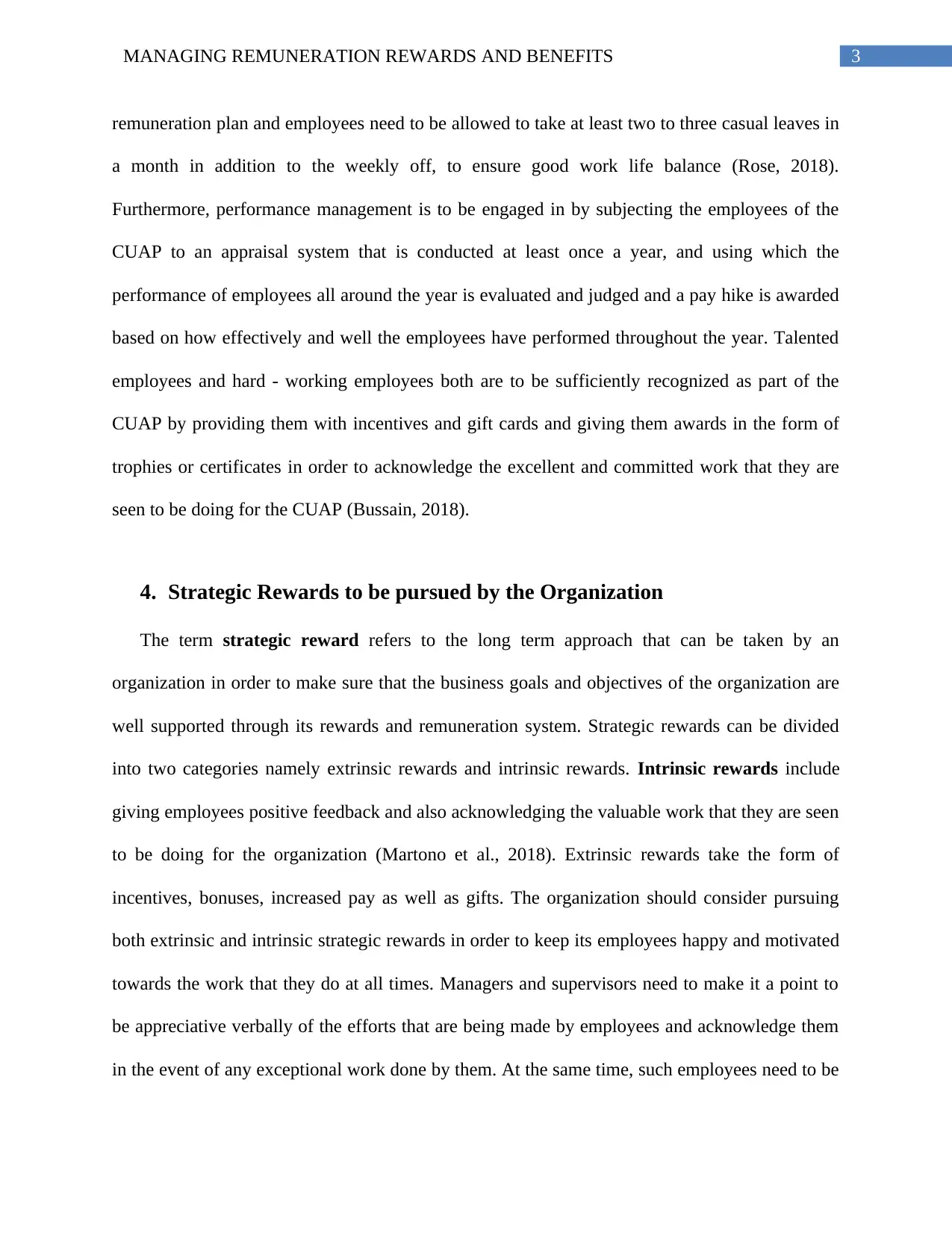
3MANAGING REMUNERATION REWARDS AND BENEFITS
remuneration plan and employees need to be allowed to take at least two to three casual leaves in
a month in addition to the weekly off, to ensure good work life balance (Rose, 2018).
Furthermore, performance management is to be engaged in by subjecting the employees of the
CUAP to an appraisal system that is conducted at least once a year, and using which the
performance of employees all around the year is evaluated and judged and a pay hike is awarded
based on how effectively and well the employees have performed throughout the year. Talented
employees and hard - working employees both are to be sufficiently recognized as part of the
CUAP by providing them with incentives and gift cards and giving them awards in the form of
trophies or certificates in order to acknowledge the excellent and committed work that they are
seen to be doing for the CUAP (Bussain, 2018).
4. Strategic Rewards to be pursued by the Organization
The term strategic reward refers to the long term approach that can be taken by an
organization in order to make sure that the business goals and objectives of the organization are
well supported through its rewards and remuneration system. Strategic rewards can be divided
into two categories namely extrinsic rewards and intrinsic rewards. Intrinsic rewards include
giving employees positive feedback and also acknowledging the valuable work that they are seen
to be doing for the organization (Martono et al., 2018). Extrinsic rewards take the form of
incentives, bonuses, increased pay as well as gifts. The organization should consider pursuing
both extrinsic and intrinsic strategic rewards in order to keep its employees happy and motivated
towards the work that they do at all times. Managers and supervisors need to make it a point to
be appreciative verbally of the efforts that are being made by employees and acknowledge them
in the event of any exceptional work done by them. At the same time, such employees need to be
remuneration plan and employees need to be allowed to take at least two to three casual leaves in
a month in addition to the weekly off, to ensure good work life balance (Rose, 2018).
Furthermore, performance management is to be engaged in by subjecting the employees of the
CUAP to an appraisal system that is conducted at least once a year, and using which the
performance of employees all around the year is evaluated and judged and a pay hike is awarded
based on how effectively and well the employees have performed throughout the year. Talented
employees and hard - working employees both are to be sufficiently recognized as part of the
CUAP by providing them with incentives and gift cards and giving them awards in the form of
trophies or certificates in order to acknowledge the excellent and committed work that they are
seen to be doing for the CUAP (Bussain, 2018).
4. Strategic Rewards to be pursued by the Organization
The term strategic reward refers to the long term approach that can be taken by an
organization in order to make sure that the business goals and objectives of the organization are
well supported through its rewards and remuneration system. Strategic rewards can be divided
into two categories namely extrinsic rewards and intrinsic rewards. Intrinsic rewards include
giving employees positive feedback and also acknowledging the valuable work that they are seen
to be doing for the organization (Martono et al., 2018). Extrinsic rewards take the form of
incentives, bonuses, increased pay as well as gifts. The organization should consider pursuing
both extrinsic and intrinsic strategic rewards in order to keep its employees happy and motivated
towards the work that they do at all times. Managers and supervisors need to make it a point to
be appreciative verbally of the efforts that are being made by employees and acknowledge them
in the event of any exceptional work done by them. At the same time, such employees need to be
Paraphrase This Document
Need a fresh take? Get an instant paraphrase of this document with our AI Paraphraser
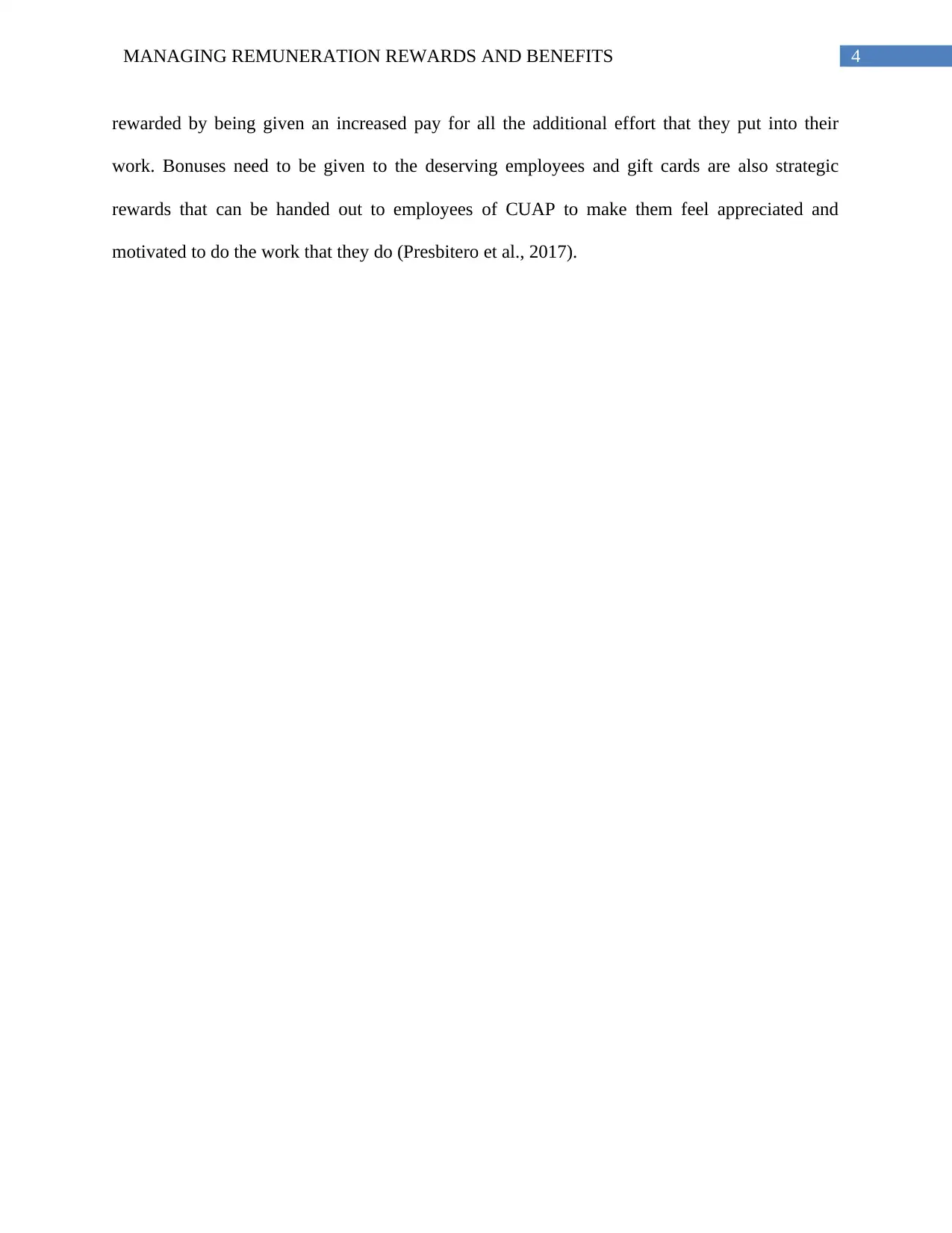
4MANAGING REMUNERATION REWARDS AND BENEFITS
rewarded by being given an increased pay for all the additional effort that they put into their
work. Bonuses need to be given to the deserving employees and gift cards are also strategic
rewards that can be handed out to employees of CUAP to make them feel appreciated and
motivated to do the work that they do (Presbitero et al., 2017).
rewarded by being given an increased pay for all the additional effort that they put into their
work. Bonuses need to be given to the deserving employees and gift cards are also strategic
rewards that can be handed out to employees of CUAP to make them feel appreciated and
motivated to do the work that they do (Presbitero et al., 2017).
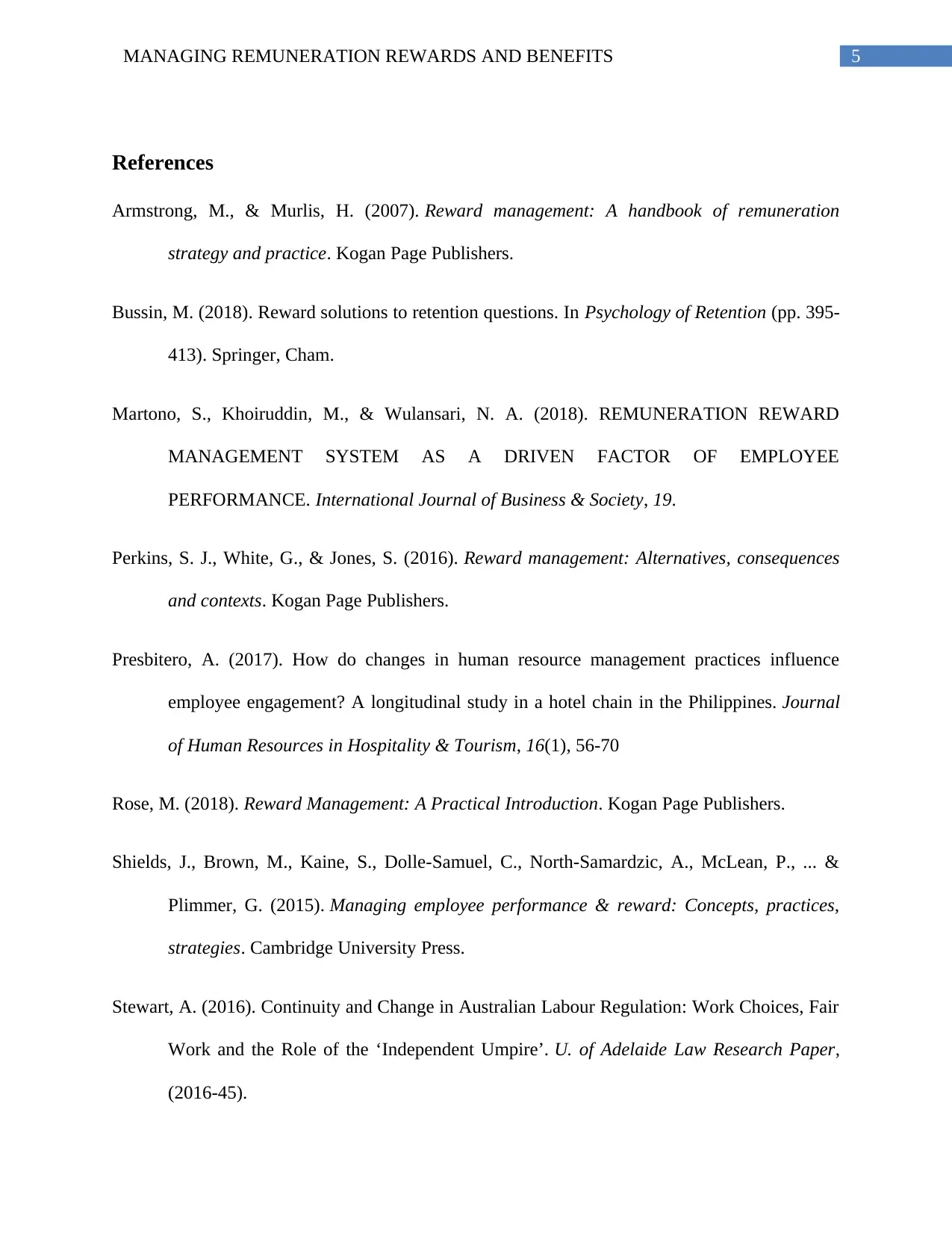
5MANAGING REMUNERATION REWARDS AND BENEFITS
References
Armstrong, M., & Murlis, H. (2007). Reward management: A handbook of remuneration
strategy and practice. Kogan Page Publishers.
Bussin, M. (2018). Reward solutions to retention questions. In Psychology of Retention (pp. 395-
413). Springer, Cham.
Martono, S., Khoiruddin, M., & Wulansari, N. A. (2018). REMUNERATION REWARD
MANAGEMENT SYSTEM AS A DRIVEN FACTOR OF EMPLOYEE
PERFORMANCE. International Journal of Business & Society, 19.
Perkins, S. J., White, G., & Jones, S. (2016). Reward management: Alternatives, consequences
and contexts. Kogan Page Publishers.
Presbitero, A. (2017). How do changes in human resource management practices influence
employee engagement? A longitudinal study in a hotel chain in the Philippines. Journal
of Human Resources in Hospitality & Tourism, 16(1), 56-70
Rose, M. (2018). Reward Management: A Practical Introduction. Kogan Page Publishers.
Shields, J., Brown, M., Kaine, S., Dolle-Samuel, C., North-Samardzic, A., McLean, P., ... &
Plimmer, G. (2015). Managing employee performance & reward: Concepts, practices,
strategies. Cambridge University Press.
Stewart, A. (2016). Continuity and Change in Australian Labour Regulation: Work Choices, Fair
Work and the Role of the ‘Independent Umpire’. U. of Adelaide Law Research Paper,
(2016-45).
References
Armstrong, M., & Murlis, H. (2007). Reward management: A handbook of remuneration
strategy and practice. Kogan Page Publishers.
Bussin, M. (2018). Reward solutions to retention questions. In Psychology of Retention (pp. 395-
413). Springer, Cham.
Martono, S., Khoiruddin, M., & Wulansari, N. A. (2018). REMUNERATION REWARD
MANAGEMENT SYSTEM AS A DRIVEN FACTOR OF EMPLOYEE
PERFORMANCE. International Journal of Business & Society, 19.
Perkins, S. J., White, G., & Jones, S. (2016). Reward management: Alternatives, consequences
and contexts. Kogan Page Publishers.
Presbitero, A. (2017). How do changes in human resource management practices influence
employee engagement? A longitudinal study in a hotel chain in the Philippines. Journal
of Human Resources in Hospitality & Tourism, 16(1), 56-70
Rose, M. (2018). Reward Management: A Practical Introduction. Kogan Page Publishers.
Shields, J., Brown, M., Kaine, S., Dolle-Samuel, C., North-Samardzic, A., McLean, P., ... &
Plimmer, G. (2015). Managing employee performance & reward: Concepts, practices,
strategies. Cambridge University Press.
Stewart, A. (2016). Continuity and Change in Australian Labour Regulation: Work Choices, Fair
Work and the Role of the ‘Independent Umpire’. U. of Adelaide Law Research Paper,
(2016-45).
⊘ This is a preview!⊘
Do you want full access?
Subscribe today to unlock all pages.

Trusted by 1+ million students worldwide
1 out of 6
Related Documents
Your All-in-One AI-Powered Toolkit for Academic Success.
+13062052269
info@desklib.com
Available 24*7 on WhatsApp / Email
![[object Object]](/_next/static/media/star-bottom.7253800d.svg)
Unlock your academic potential
Copyright © 2020–2025 A2Z Services. All Rights Reserved. Developed and managed by ZUCOL.





